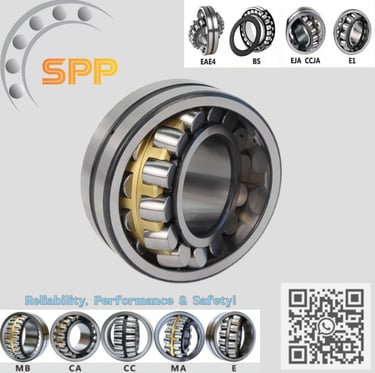Understanding the Differences Between 'CA' and 'MB' Suffixes in Bearing Cages


Introduction to Bearing Cages and Their Suffixes
Bearing cages, also known as retainers or separators, are critical components in the design and functionality of bearings. These cages serve to maintain the relative position of rolling elements within a bearing, ensuring they remain evenly spaced and operate smoothly. By doing so, bearing cages effectively reduce friction and wear, thereby enhancing the performance and longevity of the bearing system.
The primary function of a bearing cage is to prevent the rolling elements from coming into direct contact with one another, which would otherwise lead to increased friction, heat generation, and potential damage. In addition to facilitating the smooth rotation of the rolling elements, bearing cages also help in the even distribution of load and minimize the risk of misalignment.
Bearings come in various designs and configurations, each tailored to specific applications and operating conditions. To distinguish between these different types, manufacturers use suffixes such as 'CA' and 'MB'. These suffixes are appended to the bearing's model number and indicate the specific design of the cage used within the bearing.
The 'CA' suffix typically denotes a bearing cage made from machined brass or bronze, known for its durability and high load-carrying capacity. On the other hand, the 'MB' suffix usually refers to a bearing cage constructed from a two-piece pressed brass design, which is known for its lightweight nature and cost-effectiveness. Understanding these suffixes and their implications can help in selecting the appropriate bearing for a given application, ensuring optimal performance and reliability.
In the following sections, we will delve deeper into the specifics of 'CA' and 'MB' bearing cages, comparing their characteristics, advantages, and potential applications, to provide a comprehensive understanding of their differences.
Characteristics and Applications of 'CA' Bearing Cages
'CA' bearing cages are renowned for their robust construction and exceptional performance in demanding applications. These cages are typically manufactured from high-grade steel or brass, materials chosen for their superior strength, durability, and resistance to wear and tear. The design of 'CA' bearing cages often includes precise machining and finishing processes that ensure optimal alignment and minimal friction during operation.
One of the standout features of 'CA' bearing cages is their ability to maintain structural integrity under high load conditions. This makes them ideal for use in heavy machinery and industrial applications where reliability is paramount. The robust material composition of these cages contributes to their long service life, even in environments subjected to extreme temperatures or corrosive elements.
The benefits of using 'CA' bearing cages extend beyond their strength and durability. Their design also facilitates efficient lubrication distribution, which is crucial for maintaining smooth operation and reducing maintenance intervals. This efficiency in lubrication helps in minimizing operational downtime and enhances the overall performance of the machinery.
'CA' bearing cages find widespread application across various industries. In the automotive sector, they are commonly used in engines, transmissions, and wheel assemblies due to their ability to withstand high rotational speeds and heavy loads. In the aerospace industry, 'CA' cages are a preferred choice for critical components such as jet engines and landing gear systems, where reliability and performance are non-negotiable.
Real-world examples underscore the efficacy of 'CA' bearing cages. For instance, in high-speed rail systems, these cages play a pivotal role in ensuring the smooth and safe operation of the trains. Performance metrics from such applications often highlight the exceptional load-bearing capacity and longevity of 'CA' cages, further solidifying their reputation in the industry.
In summary, 'CA' bearing cages are characterized by their robust material composition, efficient design features, and versatile applications across industries. Their ability to perform reliably under strenuous conditions makes them an indispensable component in many mechanical systems.
Characteristics and Applications of 'MB' Bearing Cages
The 'MB' suffix in bearing cages indicates a specific type of design and material used in their construction. 'MB' bearing cages are typically made from brass, which provides several distinct advantages. Brass is known for its excellent anti-friction properties, high strength, and good corrosion resistance. These characteristics make 'MB' bearing cages particularly suited for demanding applications where reliability and longevity are paramount.
One of the key design features of 'MB' bearing cages is their machined brass construction. This design ensures a precise fit and uniform distribution of load across the bearing, enhancing the overall performance and lifespan of the bearing assembly. The robust nature of brass allows 'MB' cages to withstand high-speed operations and heavy loads, making them ideal for use in industries that demand high-performance bearing solutions.
Typical applications of 'MB' bearing cages include heavy machinery, automotive engines, and aerospace components. In these environments, the ability to endure high stress and resist wear and tear is crucial. The brass material also provides superior thermal conductivity, which helps dissipate heat generated during operation, further contributing to the bearing's efficiency and durability.
When comparing 'MB' bearing cages to 'CA' bearing cages, it is essential to consider the specific requirements of the application. While 'CA' cages, often made from steel or polyamide, offer certain benefits such as lower weight and cost, 'MB' cages excel in scenarios where maximum strength and durability are required. The choice between 'MB' and 'CA' bearing cages ultimately depends on the operational demands and environmental conditions of the intended application.
In conclusion, 'MB' bearing cages stand out for their robust construction, high load-bearing capacity, and excellent durability. Their suitability for high-stress, high-speed applications makes them a preferred choice in industries where performance cannot be compromised. Understanding these characteristics helps in making informed decisions when selecting bearing cages for specific uses.
